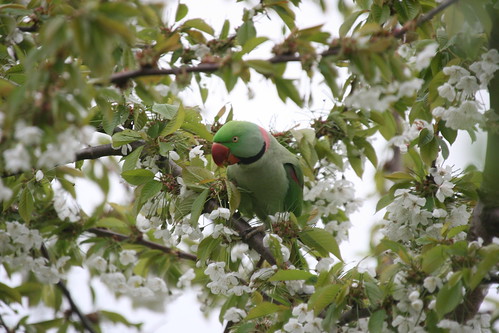 Alexandrine parakeet (Psittacula eupatria)
Alexandrine parakeet (Psittacula eupatria)
INDORE: The city has become less chirpy due to the disappearance of parakeets. These birds commonly seen in green covers like parks and gardens have become a rare sight.
Urbanization, coupled with a rampant deforestation and rising pollution, is the prime reason behind the decline in the number of birds, say animal rights activists.
"Common small parrots or parakeets, called Alexandrian parakeets and also known as rose-ringed parakeet, are fast vanishing. Flocks of plum-headed parakeets, commonly spotted a few years back, too have taken the vanishing flight,'' says animal activist Ajay Gadikar.
The birds could be commonly seen in the city's green pockets like Piplya Pala, Bilawali and Talawali Chanda. Birds like Egyptian vultures, Indian sparrows and migratory ducks too are vanishing from the city. "Unchecked urbanization and a parallel deforestation have led to the disappearance of these beautiful creatures. Parakeets are known to nest in the hollows of big trees like peepal, banyan and mango. With invasive cutting of trees, they have now little scope for nesting," says Gadikar.
"Safety and food are two important factors for the choice of habitat for these birds. These basic requirements have become scant with trees being cut. Also, less greenery means less insects which translates in to less food for these birds. Insects are the integral part of the food 90% of birds specially the young ones of most birds need insects to provide them complete nutrition.
Birds like pigeons have better survival mechanism and can survive even with fewer trees, as they don't have any specific food needs like parakeets", said Gadikar.
However DFO Indore, Saeed Khan did not seem to agree that deforestation could be a prime reason for decline in population of these birds. According to protocol more trees are planted for any planned deforestation. "The development authorities plant trees to compensate for the trees they have cut. Although we don't have any surveys to confirm, the situation of parrot population but lesser visibility may only suggest that the birds have relocated."
Pravar Mourya another bird watcher said, "Newly planted trees as compensation,don't exactly create the same conditions that the parakeets need for their habitat. They need old trees, not less than 15-20 years old having cavities in their barks. These trees will take years to develop those natural spaces.Also the planned plantations are not as diverse as the natural forests we cut. Less diversity means less favourable conditions for the plants."
 Alexandrine parakeet (Psittacula eupatria)
Alexandrine parakeet (Psittacula eupatria)